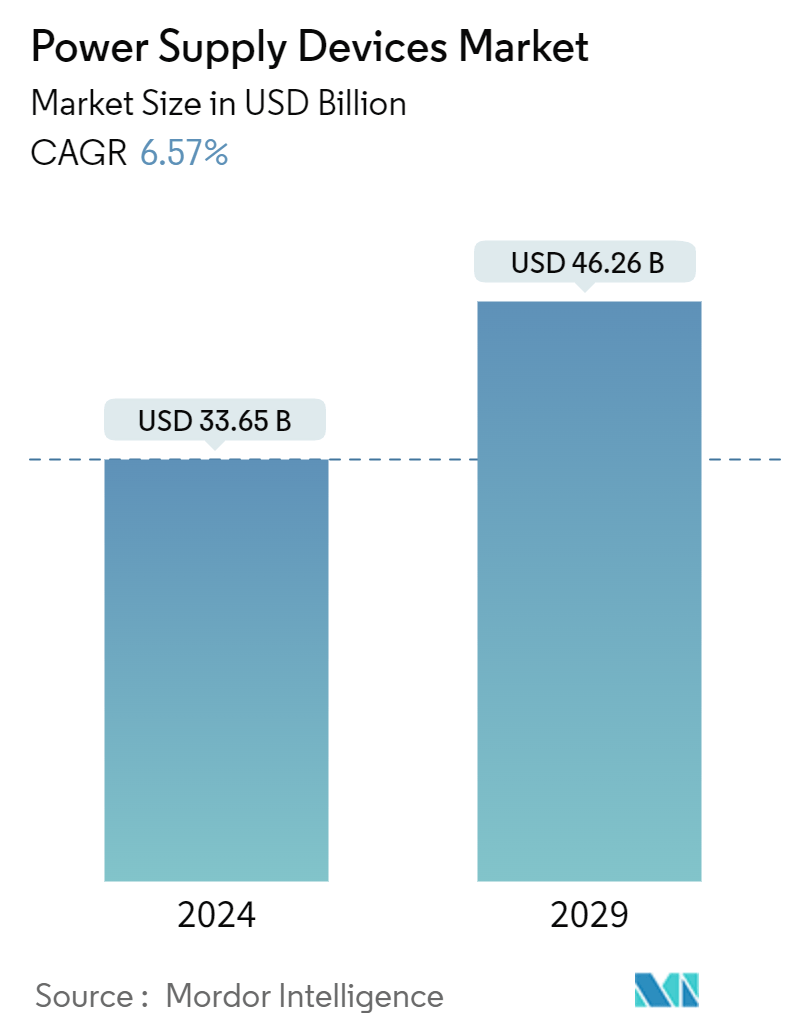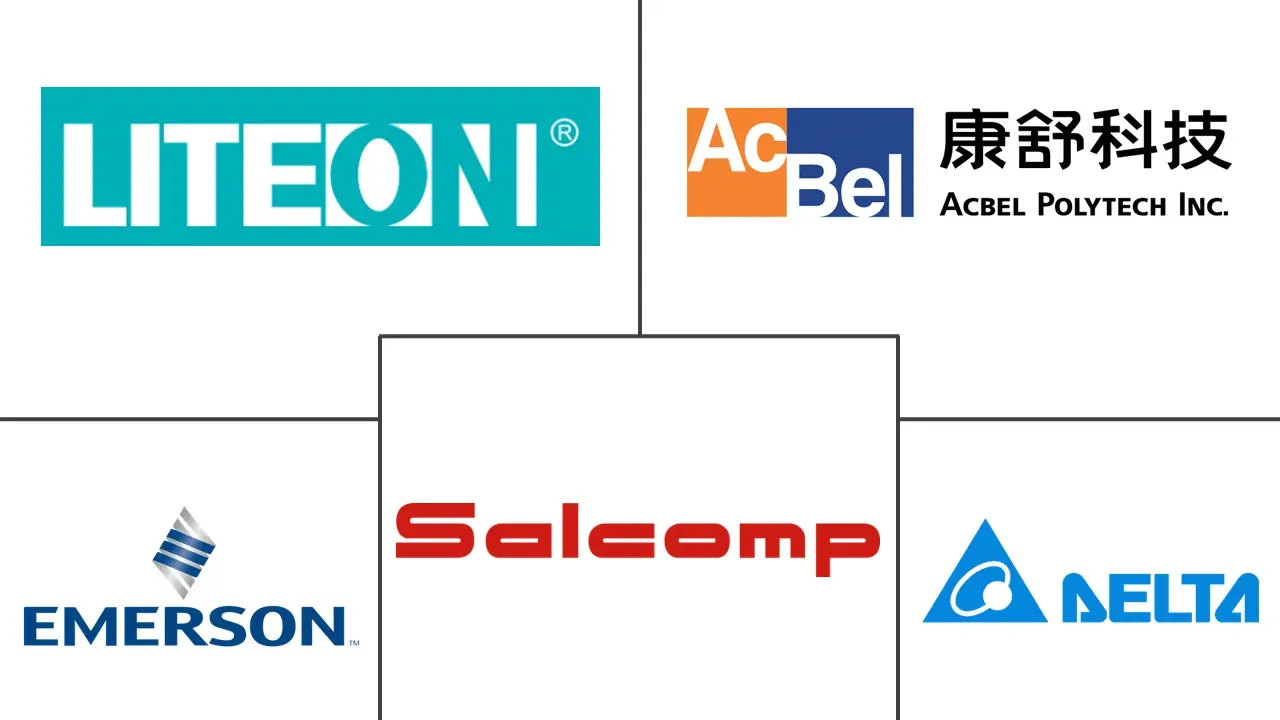Market Size of Power Supply Devices Industry

| Study Period | 2019 - 2029 |
| Market Size (2024) | USD 33.65 Billion |
| Market Size (2029) | USD 46.26 Billion |
| CAGR (2024 - 2029) | 6.57 % |
| Fastest Growing Market | Asia Pacific |
| Largest Market | Asia Pacific |
Major Players
*Disclaimer: Major Players sorted in no particular order |
Power Supply Devices Market Analysis
The Power Supply Devices Market size is estimated at USD 33.65 billion in 2024, and is expected to reach USD 46.26 billion by 2029, growing at a CAGR of 6.57% during the forecast period (2024-2029).
The market has experienced significant growth due to the increasing popularity of home and building automation systems. There is a high demand for power supply in various industries, such as consumer electronics, medical & healthcare, and military & aerospace, which presents a profitable opportunity for the market.
- A power supply is an electrical apparatus that delivers electric power to an electrical load. The primary objective of a power supply is to transform electric current from a source into the appropriate voltage, current, and frequency required to energize the load. Consequently, power supplies are occasionally denoted as electric power converters. Certain power supplies are independent units, whereas others are integrated into the load appliances they energize. The progressions in power supply technology throughout the years have yielded numerous benefits. Through the utilization of sophisticated circuitry and components, power supplies can furnish a steady voltage output while minimizing energy wastage.
- Throughout history, humans have been utilizing the sun, wind, and water as sources of energy. However, with the advancements in technology, these ancient energy forms have evolved into advanced power generation sources. In line with this, power supply devices become increasingly popular over the years, as they play a crucial role in providing energy to electric loads for consumption and operation. The growing demand for power supply in various industries and industrial equipment is anticipated to boost its demand further.
- The primary purpose of a power supply is to transform electric current from a source into the appropriate voltage, current, and frequency required to operate the load. This conversion may involve either changing AC to DC or DC to DC. As a result, power supplies are often referred to as electric power converters. The primary function of a power supply is to monitor and adjust the current and voltage of electrical power to ensure that the correct amount of energy is delivered to the load. While some power supplies are integrated into electrical appliances, others are installed separately to prevent any electrical malfunctions in the appliances.
- The majority of electronic devices available for purchase must adhere to EMC and EMI (electromagnetic compatibility and electromagnetic interference) regulations. These regulations ensure that the devices do not interfere with the operation of other equipment and that external electrical noise does not hinder the proper functioning of certified equipment. DC power supplies must undergo certification and comply with regulatory requirements. Failure to do so may result in declining sales of these power supplies.
- There has been a noticeable increase in demand for power supply devices in consumer electronics and automotive sectors, largely due to the growing adoption of electric vehicles. The rising demand for automation technologies is expected to propel the market further.
Power Supply Devices Industry Segmentation
A power supply is an electrical device that provides electric power to an electrical load. The primary objective of a power supply is to transform electric current from a source into the appropriate voltage, current, and frequency required to energize the load. The power may originate from various sources, including the electric power grid (an electrical outlet), energy storage devices like batteries or fuel cells, generators or alternators, solar power converters, and other power supplies.
The power supply devices market is segmented into device type (AC-DC power supplies, DC-DC converters), end-user industry (communication, industrial, consumer and mobile, automotive, transportation, lighting), geography (Americas, Europe, Middle East and Africa (EMEA), and Asia-Pacific). The market size and forecasts are provided in terms of value (USD) for all the above segments.
| By Device Type | |
| AC-DC Power Supplies | |
| DC-DC Converters |
| By End-user Industry | |
| Communication | |
| Industrial | |
| Consumer and Mobile | |
| Automotive | |
| Transportation | |
| Lighting | |
| Other End-user Industries |
| By Geography*** | |
| Americas | |
| Europe | |
| Asia | |
| Australia and New Zealand | |
| Middle East and Africa |
Power Supply Devices Market Size Summary
The power supply devices market is poised for substantial growth, driven by the increasing demand across various sectors such as consumer electronics, medical and healthcare, and military and aerospace. This growth is largely attributed to the rising popularity of home and building automation systems, as well as the burgeoning adoption of electric vehicles. Power supply devices, which are essential for converting and regulating electric current to meet the specific needs of electrical loads, are becoming increasingly integral in these industries. The advancements in power supply technology, including the use of sophisticated circuitry, have enhanced their efficiency and reduced energy wastage, further propelling market expansion. The demand for compact and efficient power supply solutions is particularly notable in the wearable devices segment, where battery life and uninterrupted usage are critical.
Regionally, Asia-Pacific stands out as a significant growth area, with countries like China, India, and South Korea leading the charge due to their robust consumer electronics production capabilities and investments in technological advancements such as 5G and IoT. The region's market growth is also supported by initiatives like 'Digital India' and 'Smart City' projects, which are driving the adoption of electronic products. Additionally, the medical devices sector in Asia-Pacific is experiencing increased investments, boosting the demand for AC/DC converters. The market is semi-consolidated, with major players like Delta Electronics Inc., Emerson Electric Co., and LITE-ON Technology Corporation actively engaging in partnerships and acquisitions to enhance their offerings and maintain a competitive edge. Recent developments, such as LITEON's introduction of a Level 3 EV DC fast charger and AcBel Polytech Inc.'s acquisition of ABB Ltd's Power Conversion division, highlight the ongoing innovation and strategic maneuvers within the market.
Power Supply Devices Market Size - Table of Contents
-
1. MARKET INSIGHTS
-
1.1 Market Overview
-
1.2 Industry Attractiveness - Porters Five Forces Analysis
-
1.2.1 Bargaining Power of Suppliers
-
1.2.2 Bargaining Power of Buyers
-
1.2.3 Threat of New Entrants
-
1.2.4 Threat of Substitutes
-
1.2.5 Intensity of Competitive Rivalry
-
-
1.3 Industry Supply Chain Analysis
-
1.4 Impact of COVID-19 Aftereffects and Other Macroeconomic Factors on the Market
-
-
2. MARKET SEGMENTATION
-
2.1 By Device Type
-
2.1.1 AC-DC Power Supplies
-
2.1.2 DC-DC Converters
-
-
2.2 By End-user Industry
-
2.2.1 Communication
-
2.2.2 Industrial
-
2.2.3 Consumer and Mobile
-
2.2.4 Automotive
-
2.2.5 Transportation
-
2.2.6 Lighting
-
2.2.7 Other End-user Industries
-
-
2.3 By Geography***
-
2.3.1 Americas
-
2.3.2 Europe
-
2.3.3 Asia
-
2.3.4 Australia and New Zealand
-
2.3.5 Middle East and Africa
-
-
Power Supply Devices Market Size FAQs
How big is the Power Supply Devices Market?
The Power Supply Devices Market size is expected to reach USD 33.65 billion in 2024 and grow at a CAGR of 6.57% to reach USD 46.26 billion by 2029.
What is the current Power Supply Devices Market size?
In 2024, the Power Supply Devices Market size is expected to reach USD 33.65 billion.

